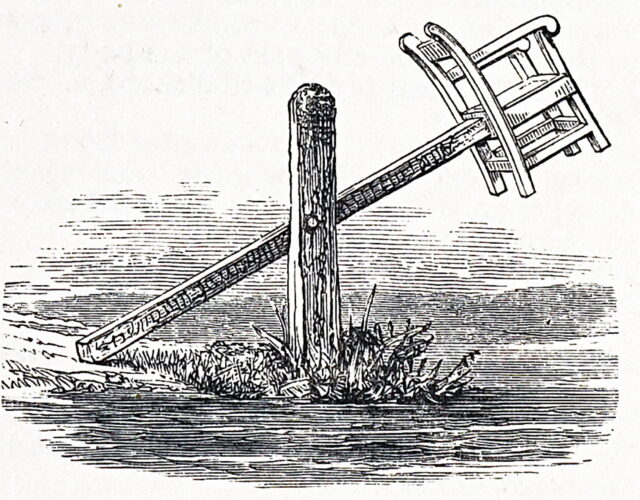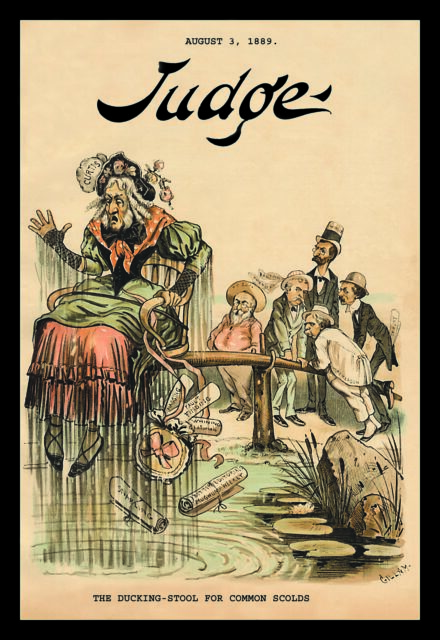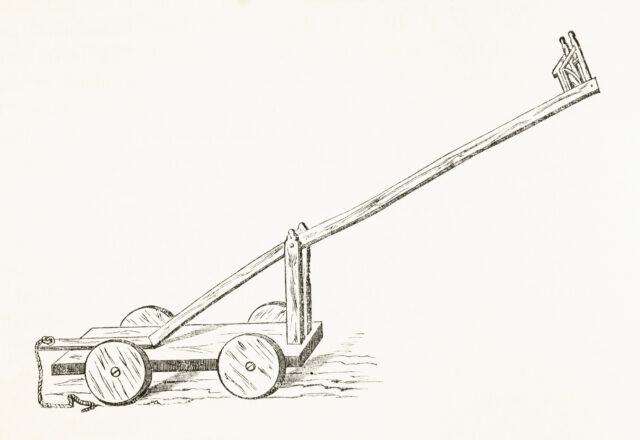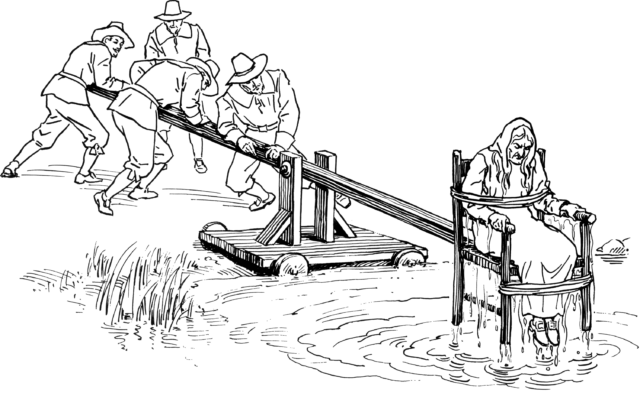The medieval period is well known for the plethora of torturous devices that were used to both punish and extract information from their victims. Among the arsenal of tools available for corporal punishment, less lethal ones existed. One of these was the ducking stool, which was used as a means of humiliation rather than as a death sentence.
What was the ducking stool?
The ducking stool was a contraption used as a means of punishment during medieval times. It was comprised of a chair that was fastened to a long wooden beam, creating a seesaw effect. The chair was equipped with iron restraints to hold the victim in place, and the whole device was often mounted onto wheels for easy transportation. Some iterations of the device had the chair hanging by a chain from a balancing beam.

The purpose of the ducking stool was to humiliate the offender by parading them around their community while they were strapped into the device. Then, they would be brought to the edge of a river where they would be seesawed and plunged into the water.
The oldest written record of the use of a ducking stool was in England in 1597. However, the practice was adopted elsewhere, including in Scotland and the English colonies in North America. The ducking stools were often made locally and would either be stowed away until required for use or permanently stationed at the edge of a riverbank as an imposing warning device.
There were cases when the ducking stool proved fatal, as some of the victims died from shock or from drowning. Abandonment of the practice wasn’t seen until the early 19th century.
The main victim was the ‘common scold’
Multiple offenses required punishment by ducking stool, such as prostitution or adultery, but none were as frequent as the “common scold.” The common scold was usually a woman, specifically one who spoke poorly about and toward her husband. Common scolds were loud or behaved in a manner that was not befitting of a dutiful wife.

Once a woman was deemed a common scold, the magistrate would determine how many duckings into the water they were to receive. Often, onlookers would yell, “Duck the scold! Duck the scold!”
Two punishments often confused with ducking
There were two other forms of punishment sometimes mistaken for the ducking stool, but these served different purposes. The first is the cucking stool, which is noticeably similar in name alone. The device is significantly older than the ducking stool, dating back to the 13th and 14th centuries, and was a form of punishment used for both men and women.
The ducking stool was derived from the cucking stool, and so the two do share similarities in their composition. The cucking stool was a chair, sometimes a toilet, that was placed in a public setting so that the person who was restrained while sitting upon it suffered public humiliation. In some cases, the chair was rigged so that it could be trotted around town to further the victim’s shame.

The cucking stool was used in cases of drunkenness, sexual offenses, gossip, and against dishonest merchants. However, the punishment derived from the cucking stool was a lot less severe and dangerous than that provided by the ducking stool.
The second punishment often mistaken for the ducking stool was the act of “swimming.” There is a misunderstanding that ducking a woman was used as a way to determine if she was a witch, but it was actually swimming which would determine that.
During the process of swimming, a woman’s hands would be tied to her ankles, a rope tied around her waist, and she would be thrown into deep water. If she was able to float while in that condition, she was considered a witch, clearly conspiring with the devil and denying the baptism that the water was providing her.
If the woman sank, she passed the test and was cleared of being a witch. However, the victims were often not pulled back up out of the water in time and died as a result of the “test.”
The ducking stool was a means of silencing women
Some scholars believe that the ducking stool was used, like many other punishments of the medieval period, as a means of silencing women. As the main offense for ducking was women speaking out of turn, the ducking stool is largely considered a means of policing women’s voices.
By making the ducking stool a public spectacle, it was also used to serve as an example to other women. It was used to try and scare women straight, so that if they behaved themselves, they would never have to endure the same humiliation as the woman suffering on the stool.

There is no official count of how many women were tortured while the ducking stool was in common practice. In fact, many cases of women enduring this punishment likely went unrecorded altogether. However, the accounts that were recorded mostly indicate that victims of the ducking stool were poor, old, loud women who were seen as nuisances by their neighbors.
Other scholars tend to fall into another camp that believes that the ducking stool actually did the opposite of silencing women. Apparently, several records suggest that women would become outraged immediately following their punishment. They could be heard shouting at those who ordered their ducking and those who performed it.
The case of Jenny Pipes
The last recorded ducking in England was performed on Jenny Pipes of Leominster in 1809. Like most women who endured the treatment, Pipes was accused of being a common scold for talking poorly of her husband too many times. She was found guilty and her punishment was being paraded through the town on the ducking stool until she was brought to the banks of the Kenwater river.

Gathered at the bridge were her friends and family, and even some neighbors. Like all other duckings, the punishment was meant to be a spectacle seen by the offender’s peers. Once the ducking stool was situated, Pipes was ducked into the water as many times as necessary to “cool her immoderate heat.”
As it turns out, instead of silencing Pipes, her punishment on the ducking stool actually infuriated her further. “The local legend is that [Pipes] was ducked, but she just kept on shouting,” explained cultural studies scholar Jilly Kay in her book, Gender, Media and Voice: Communicative Injustice and Public Speech. “They were trying to silence her, but she just kept coming up and shouting abuse at the magistrates. It didn’t work. It didn’t silence her. She just kept on hurling insults at the men.”
The fable of Mayor Mountjoy
Pipes wasn’t the only case in which the women who were punished on the ducking stool became irate instead of silenced. Although it is unclear if this story is true, there is a tale that describes the use of the ducking stool in Bristol during the early 1700s.

The mayor of Bristol at the time was Edmund Mountjoy. He was a man who was known to be bullied by his own wife (some would call it “hen-pecked”). The tale says that one evening, Mountjoy was out for a walk when he noticed a woman scolding her husband, similar in manner to his own wife scolding him.
Mountjoy ordered that the woman, called Mistress Blake, be punished on the ducking stool for her actions. After being ducked, Blake ridiculed Mountjoy in front of everyone who came to watch the punishment. She said that he only ordered her ducking because he was too cowardly to have his own wife ducked.
More from us: The Judas Cradle Was One of the Most Painful Torture Devices in History
Supposedly, Blake sued Mountjoy for assault and won the case. As a result of the whole ordeal, Bristol’s ducking stool was abandoned. It was used later on, after it was bought by a salesman who broke it down and turned it into snuff boxes, promising that it would protect men from their hen-pecking wives.
